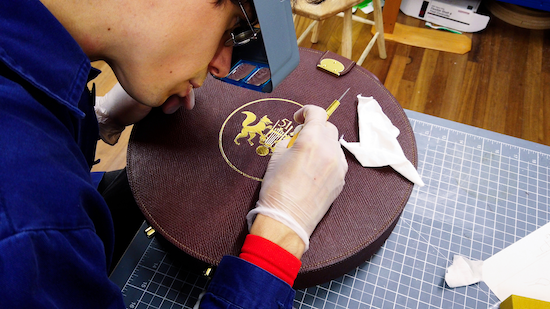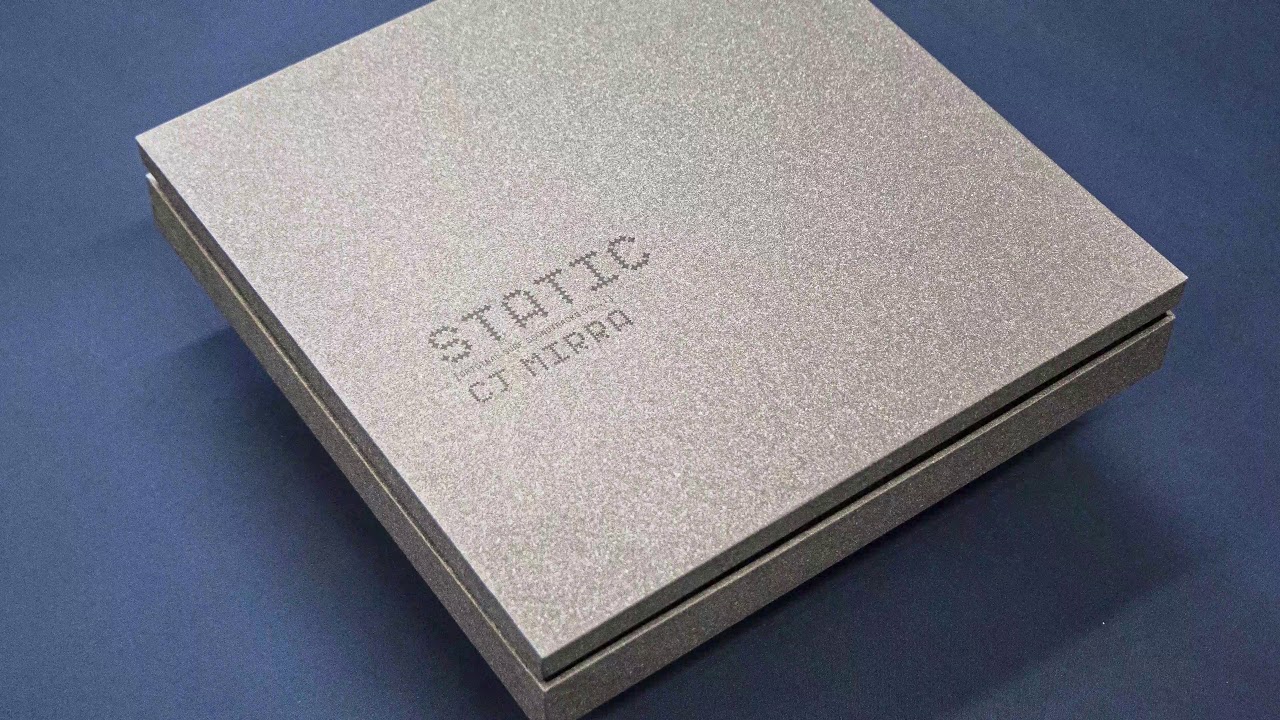Nathan Sherwood at work in The state51 Conspiracy’s atelier. Photos courtesy of The state51 Conspiracy
On 1 March this year, Kate Bush moved her entire album catalogue from its old home at Warner Music to a relatively obscure operation, tucked away in an old church hall off Bethnal Green high street, called The state51 Conspiracy. A new, “special presentation” of Hounds Of Love is due later this year. As ever, elaboration has been scant, so Bush’s reasoning must be left mainly to guesswork and inference. One might imagine, however, that the kind of work being produced in their atelier might have something to do with it.
It’s in this church hall where tQ watches resident artist Tilly de Verteuil demonstrate the box she made by hand for CJ Mirra’s STATIC, a compilation of soundtracks for arthouse films about cold water surfing. When she lifts it, it sounds exactly like the sea, like waves lapping gently against the shore if you tilt the box slowly, and like the crashes of a tempest if you give it more welly. It is uncanny: a work of art in itself that makes STATIC an immersive experience before a note of the actual music has been played. Inspired by the rainmaker she had as a child, de Verteuil spent a year working on the project, first with coffee beans, and then with the right combination of different sized steel ball bearings and hollow correx sheets that would produce such a remarkable sound. That’s to say nothing of the box itself, the artwork printed onto a mirrored surface, the box lined with soft felt.
Then, her colleague Nathan Sherwood dons a pair of white gloves, embroidered with the State51 logo – a faux-heraldic crest depicting a fox and a Pegasus, a harp and a bag of money. He carefully and precisely places a luxuriant looking, circular attaché case on his worktop. The leather, he explains, is sourced from the only remaining oak bark tannery in Britain. “You don’t see much made out of this stuff,” he says with pride. He opens it to reveal a single 10-inch vinyl copy of Donovan’s ‘Sunshine Superman’, which sits on top of vivid psych-patterned interior. The grooves of the record only take up about half of the space on the disc, the rest devoted to an intricate floral engraving. The entire flipside is engraved too, the crest here surrounded by a lattice of branches and flowers. From a smaller leather case – itself an intricate piece – he retrieves two handmade golden keys, sanded down to resemble those that might be found alongside an antique clock, and uses them to rotate the intricate inner design, the colourful outer pattern and the intricate engraving swirling around one another like a solar system.
For all the opulence of its products, the atelier has a modest and welcoming set up, two workbenches in the middle of the room strewn with half-completed record sleeves and scraps of paper, plastic, foil and card, and heavy cast-iron machines arranged along the walls. All of them were built between the Victorian period and the 1960s, sourced by de Verteuil drawing on knowledge acquired through her role as a bookbinding technician at the London College Of Communication. state51’s creative director William Reid and then-colleague Tihana Šare first met when they visited the college while looking into the history of fine bookbinding – “really expensive books that were historically religious icons that then became markers of wealth,” as de Verteuil puts it, and the possibilities of applying those principles to the music industry.
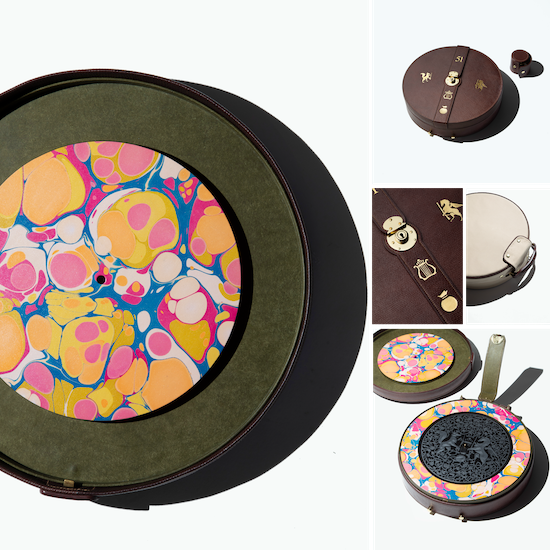
The state51 Conspiracy’s one-of-a-kind attaché case release for Donovan’s ‘Sunshine Superman’
It’s only one small part of state51’s HQ. A multi-faceted operation, it earns the majority of its money from a large distributed music catalogue. “What makes us different is the way we invest in our capabilities, driven by our goal to be a creatively led, complete destination for artists and labels,” Reid explains. As a result, not only is the atelier able to operate with comparative freedom, but also state51’s record label, the GreedMag publication – which is distributed for free to those who purchase from them – as well as online live music sessions and more. “We wouldn’t pull out one part of those parts and say, ‘the YouTube sessions are losing us money, the atelier isn’t pulling its weight. We have to look at it as a whole. The gestalt, if you like.” De Verteuil and Sherwood are therefore gifted with a rare kind of creative freedom – both took on the Mirra and Donovan releases respectively after being given free rein to pick something they liked out of a pile of upcoming releases. “I remember the conversation,” says Reid. “It was something like, ‘we’ve got a bunch of music here, override any preconceptions about unit cost or economies of scale, try to think about pushing either creativity and innovation to the fore, or the quality of the materials and execution. The point was to expand our ideas. In the music industry we’re often closed off, not receptive to the full potential of creativity and craft.”
This has positive knock-on effects. “When you’re handling materials that are high quality, because there’s a certain scarcity to them you do the best you can use them responsibility,” Reid explains. de Verteuil adds: “it’s accidentally, inherently sustainable because of the nature of the way that Nathan and I both work. We use everything to death, cut the offcuts smaller and smaller and use them as scraps. And at the same time, the materials we use are generally quite sustainable, if not completely recyclable.” They take inspiration from the intricacy and magnificence of a Faberge egg, Reid explains, but there’s also something to their approach akin to the Durutti Column’s infamous sandpaper sleeve LP.
For De Verteuil, the only real equivalent to the kinds of things they were able to produce are releases like Wu Tang Clan’s album Once Upon A Time In Shaolin, for which they adopted, in their words, “a 400 year old Renaissance-style approach to music” by producing just one copy held in a silver jewel-encrusted box with a wax Wu-Tang Clan seal and leather-bound liner notes, or the ‘HELL-P’ edition of Slayer’s Relentless, made from stainless steel and metallic copper and designed to still be played after being lit on fire. “But those are one-off permanently housed products, coming from ad agencies rather than the record labels themselves,” she says.
An approach like state51’s – where the format music’s delivered in is developed with unique attention to the music itself – means that for the artist, too, creative possibilities become expanded. When Mirra first received the prototype for the STATIC box, “I couldn’t believe what I was holding,” he tells tQ. “Tilly got right to the heart and soul of the record. The finished product is like a kinetic sculpture and looks and sounds incredible. I’m still so grateful they went this deep for a very niche record.” So pleased was he with their work that he’s embraced it as an instrument in its own right. “For a live A/V show called Translate which we performed at the London Surf / Film Festival with director Chris McClean, the wonderful artist and surfer Lee-Ann Curren played it live, adding sea sounds over a track called ‘Narnia, UK’. I’ve also recorded it for some of [psych project] CJ’s Mirra Maze tracks so it has become an instrument in my studio now too.”
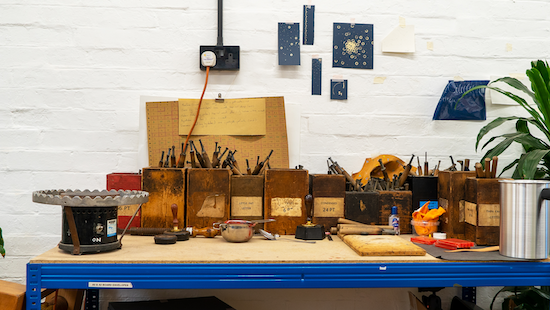
state51 are aware of the restrictive implications of releasing one-off £600 box sets. “Yes, we want to play around with luxury, but we also believe that music should be an accessible product. We didn’t want it to be so elitist that people couldn’t still buy a high-quality thing,” says Reid. This was the genesis of the 51 Editions project, sparked by a collaboration with tQ. Every equinox and solstice, subscribers to our site’s Sound & Vision tier receive digital music releases composed by some of our favourite artists. Then, further down the line, state51 produces a limited run of 51 unique hand-cut vinyl copies. A pentagonal symbol comprised of 51 dots is on both the album cover in iridescent debossed foil, and engraved onto the disc itself, for each release, a different number of the dots are illuminated, corresponding to its number in the series. Editions 1 to 50 retail for £40, while edition 51 is presented in a bespoke box, handmade specifically for that release following the ethos they established via those early one-off projects, hand-lined and marbled and incorporating aspects of the original artwork.
The concept has been met with considerable success. In 2022, the 51 Editions won the D&AD ‘Wood Pencil’ award for creative excellence, among the most prestigious in the industry. “We were up against people like Apple, companies that have teams that they pay to put in their applications for these things and creative agencies that make these things a big part of their internal metrics for how well they’re doing,” Reid says. Off the back of it, they’re applying the system to records already receiving regular releases through state51’s record label (Waclaw Zimpel’s new LP Trainspotter, for instance), and also seeking ways to streamline things even further whilst maintaining that sense of quality.
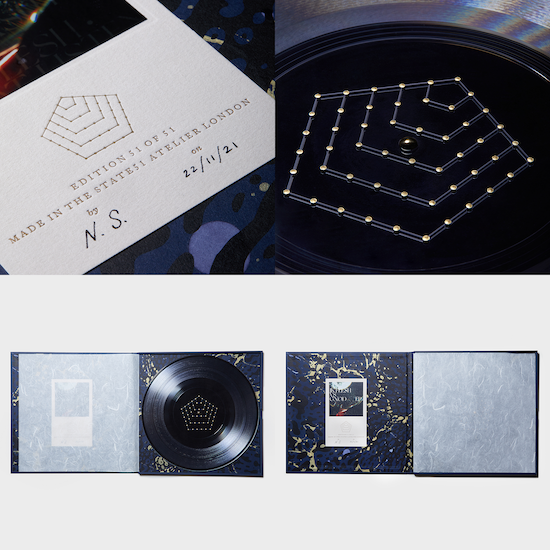
‘Edition 51’ of the first Quietus Equinox release, JK Flesh vs. Gnod
tQ has now launched a series called ‘Singularity’ running parallel to our quarterly releases, on which an artist is tasked with delivering a single piece above between 15 minutes and half an hour in length. Again, state51 produces 50 12-inch singles in expensive-feeling plastic composite sleeves – a material Sherwood in fact first found in a skip – hand-cut and engraved with the logo, and hand painted to show its serial number, as well as a 51st in a bespoke box, the vinyl wrapped in a dust sheet of fine Japanese tissue. One artist to take part was Quietus favourites Shit & Shine, and went on to release their latest album, 2222 And Airport via the label. A further showing of the synchronicities of taste, the state51’s latest album release is Memorials’ Music For Film, like Shit & Shine, a Quietus album of the week.
The use of engraving is essential to the process, for which state51 work with Bladud Flies!, a boutique studio holed away in the Cambrian mountains in Wales, and a two-person operation comprising of audio engineer Michael Lawrence and artist/designer Lauren Winton. There records are lathe cut, meaning that every copy is cut in real time with a diamond stylus. Then, the vinyl is engraved with a mechanical CNC router. In an earlier collaboration it took them over 150 hours to produce the engraving for the Donovan attaché case. “We are the only place in the world that offers this service,” Lawrence points out. “We do not use a laser as it creates a hazardous gas that is both harmful and a pollutant – it also gives a poor-quality finish.” The enthusiasm state51 has for their work is reciprocated. “We think it is the most exceptional, exciting and unique thing happening within the physical format of music right now,” Lawrence says. “Working with them is inspiring. We deliver the engraved lathes and seeing what they do with them is just phenomenal. It is a blessing to work with people who share our high standards and vision for creating the coolest and highest quality physical items possible. Long may it continue!”
state51 might be doing things differently, but their kinship with operations like Bladud Flies!, and the way their work is interwoven with the creative process of the musicians whose work they’re packaging, means they don’t exist in a vacuum. “I don’t think there’s a desire for us to be an island, I see this as part of a much wider ambition to show a unique set of capabilities across all sorts of production and creativity. I think as a music company it’s incumbent upon you to be able to generate the best possible experience you can for an artist,” Reid says. “It would be exciting for the music industry, music buyers and fans if there were more of this sort of thing going on. I think it’s genuinely quite progressive and innovative and exciting.”
In the mainstream market, the nostalgia cycle has shortened to the extent that albums just five years old are receiving ‘anniversary’ reissue presses, while ‘classics’ are being re-released stuffed with trinkets to justify exorbitant prices. The recent ‘uber deluxe’ 50th anniversary edition of George Harrison’s All Things Must Pass, for instance, sold for £859.99, and came bundled with a wooden bookmark, small replicas of the gnomes from the album’s cover, a set of Rudraksha beads and a reproduced copy of Paramahansa Yogananda’s Hindu text Light From The Great Ones (which can be purchased for $1 online), along with the standard scrapbook and slew of demos. state51 seeks not to reform, but to provide an alternative. “We’re in a dematerialised world where the actual sound carrier is now irrelevant,” says Reid. “You can listen to it on your phone, so how do you generate some kind of experience? This is our small attempt to try and rekindle that.”
To help support tQ’s partnership with The state51 Conspiracy, and to receive the music commissioned for the Equinox and Singularity series’ before anyone else along with exclusive essays, podcasts and playlists, become a top tier Quietus Sound & Vision subscriber using the links below.

